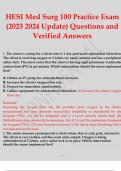Exam (elaborations)
HESI Med Surg 100 Practice Exam ( Update) Questions and Verified Answers
- Course
- Institution
HESI Med Surg 100 Practice Exam ( Update) Questions and Verified AnswersHESI Med Surg 100 Practice Exam ( Update) Questions and Verified AnswersHESI Med Surg 100 Practice Exam ( Update) Questions and Verified Answers
[Show more]



